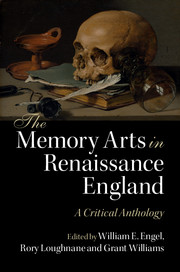Book contents
- Frontmatter
- Dedication
- Contents
- List of figures
- Acknowledgements
- A note on abbreviations
- Introduction
- PART I The art of memory
- PART II Rhetoric and poetics
- PART III Education and science
- Introduction to Part III
- III.1 Thomas Elyot, The Governor (1531)
- III.2 Roger Ascham, The Schoolmaster (1570)
- III.3 Levinus Lemnius, The Touchstone of Complexions (1576)
- III.4 William Kempe, The Education of Children (1588)
- III.5 John Brinsley, Ludus literarius (1612)
- III.6 Robert Burton, The Anatomy of Melancholy (1621)
- III.7 Thomas Sprat, The History of the Royal Society (1667)
- III.8 John Wilkins, An Essay towards a Real Character (1668)
- III.9 Obadiah Walker, Of Education (1673)
- III.10 Robert Hooke, ‘An Hypothetical Explication of Memory’ (1682)
- PART IV History and philosophy
- PART V Religion and devotion
- PART VI Literature
- Index
- References
III.6 - Robert Burton, The Anatomy of Melancholy (1621)
from PART III - Education and science
Published online by Cambridge University Press: 05 August 2016
- Frontmatter
- Dedication
- Contents
- List of figures
- Acknowledgements
- A note on abbreviations
- Introduction
- PART I The art of memory
- PART II Rhetoric and poetics
- PART III Education and science
- Introduction to Part III
- III.1 Thomas Elyot, The Governor (1531)
- III.2 Roger Ascham, The Schoolmaster (1570)
- III.3 Levinus Lemnius, The Touchstone of Complexions (1576)
- III.4 William Kempe, The Education of Children (1588)
- III.5 John Brinsley, Ludus literarius (1612)
- III.6 Robert Burton, The Anatomy of Melancholy (1621)
- III.7 Thomas Sprat, The History of the Royal Society (1667)
- III.8 John Wilkins, An Essay towards a Real Character (1668)
- III.9 Obadiah Walker, Of Education (1673)
- III.10 Robert Hooke, ‘An Hypothetical Explication of Memory’ (1682)
- PART IV History and philosophy
- PART V Religion and devotion
- PART VI Literature
- Index
- References
Summary
About the author
Robert Burton (1577–1640), a scholar of divinity, discharged various administrative duties at Oxford University, the most significant of which was Christ Church's librarian – an office he held from 1624 until his death. Supposedly he was unsurpassed in his quick-witted capacity to interlard his daily conversation with apposite lines from poets and classical authors.
About the text
One of the most popular books on philology in the seventeenth century, The Anatomy of Melancholy went through six different editions, five during his lifetime and one posthumously. Burton, who on the title page goes by his alias, Democritus Junior, calls The Anatomy a cento, which refers to a patchwork composition of quotations. The term fittingly describes his scholarly method of stitching together Latin and English scraps from numerous texts. The cento is a memory art. The Anatomy then is a book of books, truly a librarian's vision and labour. The digressive, polymathic enterprise, at times ironic and at other times theological, results in an inimitable encyclopedia on all things melancholy as though the entire cosmos could be viewed from the perspective of this affliction. Synoptic tables map out the volume's three convoluted partitions, each possessing its own sections, members and subsections: simply put, the first partition examines melancholy's causes and symptoms, the second its cures and the third its three species: love melancholy, jealousy and religious melancholy.
The arts of memory
Belonging to a formal digression on the anatomy of the human body, the excerpt affords a representative, not an innovative, account of faculty psychology. Burton succinctly redacts ideas about the brain that the early modern period inherits from a tradition stretching back to Aristotle through Thomas Aquinas and the Arab physicians. In that tradition, the faculty of memory, though operating in conjunction with the common sense and phantasy, shadows its artificial counterpart closely insofar as it designates an actual place where images are deposited.
Textual notes
Democritus Junior, The Anatomy of Melancholy, What It Is. With all the Kindes, Causes, Symptoms, Prognostickes, and Severall Cures of It (Oxford, 1621), C2r–C2v (1.1.2.7).
The Anatomy of Melancholy
Inner senses are three in number, so called because they are within the brainpan, as common sense, phantasy, memory. Their objects are not only things present, but they perceive the sensible species of things to come, past, absent, such as were before in the sense.
- Type
- Chapter
- Information
- The Memory Arts in Renaissance EnglandA Critical Anthology, pp. 166 - 168Publisher: Cambridge University PressPrint publication year: 2016
References
- 2
- Cited by

